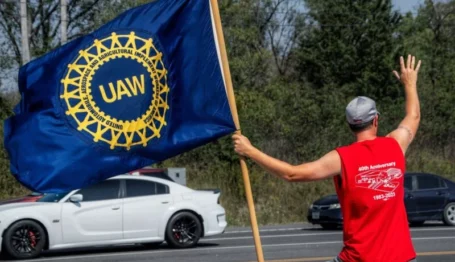Labor Watch
“Hot Labor Summer” Was a Bust
 Credit: New York State AFL-CIO.
Credit: New York State AFL-CIO.

Last year, we noted that the well-publicized march back to relevance of union organizing was not supported by the facts on union membership when the federal government released them in January. Surely after a United Auto Workers strike that drew misguided support from some ostensible conservatives, prominent strikes by Hollywood writers and actors, and mainstream media’s proclamations of a “hot labor summer,” the Everything Leftism–driven renaissance of Big Labor would appear in the national annual statistics. “Union Summer” has been proclaimed seemingly every year since 1996 when John Sweeney took over the AFL-CIO and first proclaimed the beginning of summertime for Big Labor.
But it’s happened again. Ghost of George Meany, it’s happened again.
The Data
The Bureau of Labor Statistics released its annual analysis of union membership and union density (the proportion of the workforce that is unionized) this week, and it does not support the media narrative that Americans are champing at the bit to join and pay dues to Big Labor.
Despite all the strikes, despite all the media coverage, the national union membership rate was “little changed” from 2022. It actually fell 0.1 percentage points to 10.0 percent—a drop that is presumably statistically indistinct from zero. The union membership rate in the private sector remained unchanged at 6.0 percent, while membership in the public sector fell to 32.5 percent. Total union membership ticked up, but the percentages show that union growth did not keep up with broader job creation.
What It Doesn’t Mean
So, why didn’t the “hot labor summer” lead to more unionization and, instead, leave Big Labor at (another) modern-era record low for its share of the workforce? There are micro-level and macro-level reasons for this development, but Big Labor and its allies’ preferred explanation, the supposedly oppressive stricture of the conservative Taft-Hartley consensus, is not one of them. Union supporters will point to opinion polling showing support for labor unions and declare that the only reason workers aren’t joining unions is the prevailing legal regime around union organizing that allows secret ballot decision-making, protects employers’ right to present their opinions to employees, and restricts compulsory-bargaining unionism among (and forced dues payments from) self-employed contractors.
This is the logic behind the PRO Act (now renamed for late AFL-CIO head Richard Trumka), which would among other things eliminate right-to-work laws and make forced dues a nationwide policy, eliminate restrictions on union “secondary” picketing, and classify more freelance workers as “employees” eligible for monopoly unionization and forced dues. The last item is now a proposed Biden administration regulation, despite (or perhaps because of) a similar policy’s adverse effects on self-employment and employment in general in California, long Big Labor’s Golden State.
No Stakes Breeds Comfort
So, if public policy isn’t keeping the workers of America from uniting to cast off their chains, what is? There are a few national-level reasons that might be leading workers to hold onto their pocketbooks and refrain from union organizing and dues payments. First, the polling may be an illusion of support for unions when things get real and Americans’ money—in the form of dues payments, lost pay from industrial actions, and higher prices for union-made goods—is really at stake.
Historically, the government has enacted union-regulating legislation when the salience—the level of involvement of unions in public affairs—of unions is highest. The Taft-Hartley Act, which confirmed states’ powers to pass laws against forced dues and restricted a number of disruptive union practices, was passed after the 1945–46 strike wave, the largest in U.S. history. The Landrum-Griffin Act, which further restricted disruptive union practices that enabled labor racketeering and placed disclosure rules on unions to deter and expose labor racketeering, passed after the televised McClellan Committee hearings exposed how deeply rotten Mob-infiltrated unions like the Teamsters were.
But with the culmination of the Long Decline, most Americans who want to be are insulated from the problems unions caused their grandparents. And so, unionization is remembered with rose-colored glasses rather than a weighing of costs and benefits, and that is why the polls may be as they are.
General Contentment
That brings us to individual worker-and-employer-scale reasons that Americans might be forgoing unionization. There is an old proverb among union organizers: “The best union organizer is a bad boss.” If Americans were wildly mad at their employers, the climate for union organizing would be ripe. But are they mad?
What public polling exists on Americans’ job satisfaction suggests American workers are not mad and are in fact mostly satisfied. (Of course, everybody wants higher pay; welcome to the human condition.) The Conference Board, a business trade group, found the highest level of job satisfaction since it began surveying workers on the question in 1987. Gallup, which has been asking about job satisfaction since the early 1990s, found half of workers were “completely satisfied” with their jobs, consistent with the high level of satisfaction recorded since the 2008 financial crisis.
Americans might be interested in unions in theory; that would explain the hagiographic media coverage and the polling results. But when the dues dollars hit the road, they are not mad enough at their bosses to sign on to economic disruption and a social justice agenda aligned with Everything Leftism that many working Americans do not support. That is why unions resort to coercive public policies like the PRO Act. And that is why protectors of American workers should stick to the tried-and-true Taft-Hartley consensus.



